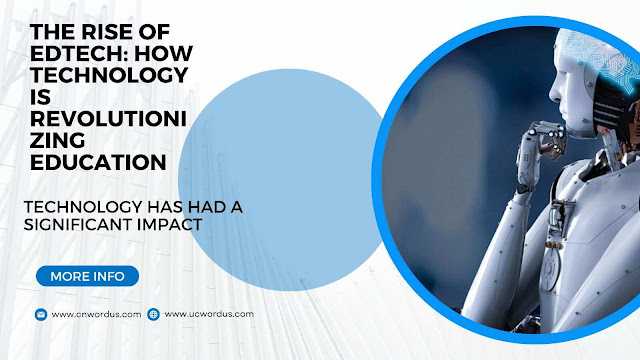The Rise of EdTech: How Technology is Revolutionizing Education
Introduction
In "The Rise of EdTech: How Technology is Revolutionizing Education," we embark on a journey to explore the transformative power of technology within the realm of learning. From digital classrooms to interactive learning platforms, EdTech has not only changed the way we access information but also the way we engage with it. It has democratized education, making it accessible to learners of all ages and backgrounds, breaking down geographical barriers, and fostering a global learning community.
Another area where technology has made a significant impact is in personalized learning. With adaptive learning software, students can receive individualized instruction tailored to their unique needs and learning styles. These tools track students' progress and provide feedback, helping them to master concepts at their own pace.
From Chalkboards to Tablets The Evolution of Classroom Technology
The evolution of classroom technology has transformed the way students learn and teachers teach. From the traditional chalkboards to modern-day tablets, there has been a significant shift in the tools used in education.
In the past, chalkboards were the primary teaching tool in classrooms. Teachers would write lessons on the blackboard using chalk, and students would take notes using pencils and notebooks. This method allowed for interactive teaching, as teachers could easily erase and modify their writing. However, it had limitations in terms of visibility and accessibility, as only one person at a time could write on the board, and the information was not easily distributable.
Over time, classroom technology began to advance, and projectors and overhead projectors were introduced. These devices allowed teachers to display content from printed materials onto a screen or wall, making it easier for all students to see. This brought a new level of visual aids into the classroom and enhanced the learning experience.
In recent years, the introduction of tablets has revolutionized classroom technology even further. With tablets, students and teachers have access to a wide range of educational resources, interactive learning applications, and digital textbooks. Tablets offer a more personalized learning experience, as students can work at their own pace and explore topics of interest. They also promote collaboration and engagement, as students can easily share their work and collaborate on projects.
Furthermore, tablets provide access to multimedia content, such as videos, images, and interactive simulations, which can make complex concepts more accessible and engaging. Teachers can also use various educational apps to create interactive exercises, quizzes, and assessments, making learning more interactive and dynamic.
Here are 10 EdTech tools that every educator should know
1. Google Classroom: A platform that enables teachers to create and manage courses online, distribute assignments, and communicate with students.
2. Kahoot!: An interactive learning platform that allows educators to create quizzes, surveys, and discussions to engage students in a fun and gamified way.
3. Nearpod: A tool that enables teachers to create and deliver interactive lessons, quizzes, and collaborative activities to engage students in real-time.
4. Edpuzzle: A platform that allows educators to create customized video lessons with embedded quizzes and interactive elements to enhance student learning.
5. Quizlet: A study tool that provides flashcards, quizzes, and games to help students review and reinforce their knowledge in various subjects.
6. Flipgrid: A video discussion platform that facilitates asynchronous communication and enables students to share their thoughts and ideas through short videos.
7. Screencastify: A screen recording tool that allows educators to create video tutorials, demonstrations, and feedback for students.
8. Padlet: A digital bulletin board where educators and students can collaborate, share ideas, and contribute resources.
9. Canva: A graphic design tool that educators can use to create visually appealing presentations, infographics, and other visual materials.
10. Remind: A communication platform that allows educators to send messages, announcements, and reminders to students and parents via text messaging and push notifications.
Blended Learning: How Technology is Enhancing Traditional Classroom Instruction
Blended learning refers to the integration of technology into traditional classroom instruction to enhance the learning experience. It combines face-to-face teaching methods with online learning tools and resources.
Technology has revolutionized education by expanding access to information and enabling personalized learning experiences. In a blended learning model, students have the opportunity to explore concepts and engage in interactive activities online. They can access multimedia materials, collaborate with classmates, and receive immediate feedback through various online platforms.
Teachers play a crucial role in blended learning as they design and facilitate learning experiences that leverage technology. They can use learning management systems to organize resources, create interactive presentations, and track students' progress. Technology also allows for differentiated instruction, as teachers can provide individualized support and adaptive learning pathways.
Blended learning has numerous benefits for both students and teachers. It promotes student engagement and active learning, as students can interact with content in various ways. It also fosters collaboration and communication skills through online discussions and group projects. Additionally, technology enables teachers to collect and analyze data on student performance, allowing for data-driven instruction and targeted interventions.
However, blended learning also presents challenges that educators must address. Access to technology and reliable internet connectivity can be barriers for some students. Teachers need proper training and support to effectively integrate technology into their instructional practices. Additionally, maintaining a balance between online and face-to-face instruction requires careful planning and time management.
In conclusion, blended learning is a powerful approach that combines the best of traditional classroom instruction with the advantages of technology. It creates opportunities for personalized learning, collaboration, and data-driven instruction. By embracing the potential of technology, educators can enhance the learning experience and prepare students for the digital age.





0 Comments